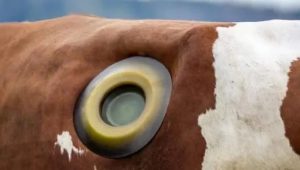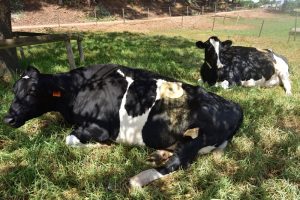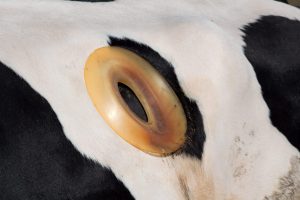You most likely see a tiny round window on a ship or airplane when you think of a “porthole,” don’t you? You’ll be surprised to learn that cows also have portholes. Cows, indeed. To gain access to cows’ stomachs, scientists and farmers have been making portholes, sometimes known as cannulas, on the animals for decades.
Although the public is not aware of this technique, which has been in place for nearly a century, it is extremely important.
What are cow portholes, exactly?
A cannulated cow, also known as a fistulated cow, is a cow that has had surgery to implant a cannula, a specialized device, in its side. In essence, it’s a surgical incision made in the cow’s stomach side.
Imagine it as a tiny, tightly-sealed “porthole,” usually encircled by a plastic ring.
Why would someone do this, then? mostly for veterinary care and research.
This arrangement eliminates the need for frequent sedation or surgery on the cow, allowing researchers to examine digestion, feed efficiency, and even how the cows assimilate various diets. That seems fairly crazy, doesn’t it?
Since the 1920s, the practice
In 1928, North Dakota Agricultural College’s Arthur Frederick Schalk and R.S. Amadon described the technique of porthole installation in cows.
Portholes were first used by researchers to better examine cow digestion. They could readily get samples of gasses, microorganisms, and partially digested food by putting in a porthole. This approach revealed information about how cows digest food and how to feed them more effectively.

For instance, a 1939 study with cannulated cows discovered that a cow’s rumen’s pH level varies throughout the day, peaking just before feeding.
Why do cows have portholes?
Cows with portholes are used by farmers and scientists to examine and enhance the digestive and general health of the animals.
They can create diets that improve milk production, accelerate growth, and even lower toxic emissions like methane by tracking how cows digest various meals. This method aims to increase farming’s productivity and sustainability.
That’s not all, though. After the initial recuperation phase, portholed cows can live long, healthy lives, according to researchers. Although there are risks associated with the intrusive treatment, several scientists contend that the cows live up to 15 years and don’t have chronic pain.
Prior to the surgery, the cow is forced to fast for a whole day without eating or drinking. The cow is awake and standing when the time for operation comes, but the area is numbed with a local anesthetic.
A rubber cannula, which functions as a porthole straight into the cow’s stomach, is then surgically inserted after a small incision is made in the cow’s side. Although the entire procedure is meticulously carried out to lessen discomfort and tension, it is still a very contentious surgery.
An action to increase food production
Better milk production and more sustainable farming are the portholes’ overarching objectives.
Farmers can feed cows in ways that minimize their influence on the environment, such as lowering methane emissions, which are a major contributor to climate change, by improving their understanding of cow digestion. Additionally, this discovery may help reduce the need for antibiotics, improving the efficiency and cleanliness of milk production.
Is it morally right, though?
Despite the practice’s obvious advantages for agriculture and science, there are others who oppose it. Animal rights organizations, such as France’s L214, contend that the process is needless and intrusive.
Some others even consider it a kind of exploitation, calling it unjust and harsh to the animals.
Many of them already have heart or lung issues, lameness, or infections. Nevertheless, we continue to push forward rather than halting this cycle. L214 shared a video showing a researcher inserting their hand into a porthole and stated, “It is time to question this unjust system.”
As a result, there have been calls to stop the practice, and petitions to permanently ban cow portholes are making the rounds in several countries.

The use of cow cannulation has drawn criticism from People for the Ethical Treatment of Animals (PETA), who contend that the procedure isn’t always in the best interests of the animal and that the recuperation period is four to six weeks.
“Cows are intelligent and sensitive animals who don’t deserve to be mutilated for any reason,” the group says, arguing that the surgery is not only intrusive but also fundamentally incorrect.
The practice appears to primarily assist the financial lines of the meat and dairy industries – maximizing diet and digestion for animals who will ultimately be exploited and slaughtered, according to PETA, despite some claims that this transfer can improve the health of cows.
Porthole substitutes
As technology develops, portholes are no longer the only way to study digestion. The development of new laboratory models that mimic the digestive tract of cows is underway.
Without requiring a live animal, these models provide insights by simulating the rumen environment. Nonetheless, a lot of researchers think that seeing a real cow up close still yields data that lab models are unable to reproduce.
Displayed portholes — and criticism
Cows with portholes are even displayed during agricultural fairs in several nations. Visitors may have a close-up look at these cows and even reach inside their bellies to witness the process of digesting.
Although the purpose of these protests is to educate the public, they have provoked outrage and protests, with many people wondering if these kinds of displays are really necessary or just exploitative.
Some big animal hospitals, veterinary institutions, and farms in North America preserve healthy cows with portholes as living donors for a procedure called a “microbiota transplant.” To put it another way, veterinarians actually reach into the cow’s stomach and remove a portion of its rumen, which is rich of beneficial microorganisms, to give to a sick cow whose digestive system isn’t functioning properly. Transfaunation is a procedure that is similar to a gut-health reboot for cows.

However, things are handled somewhat differently on the other side of the Atlantic. It is generally seen as unethical in Europe to surgically create a porthole in a cow.
Instead, to extract stomach fluid, veterinarians use a long, flexible tube with a metal filter tip that resembles a large straw. The cow can typically gather up to five liters of fluids by passing this instrument down its neck and into its stomach. Some claim it is less effective, but it is less intrusive.
Agriculture advancement against animal welfare
A broader discussion about animal welfare in agriculture is raised by the usage of portholes on cows. Critics contend that this research puts industrial profits ahead of the welfare of the animals, while supporters contend that it advances animal health and sustainability. As more people become aware of the practice, the debate is unlikely to go away anytime soon.
